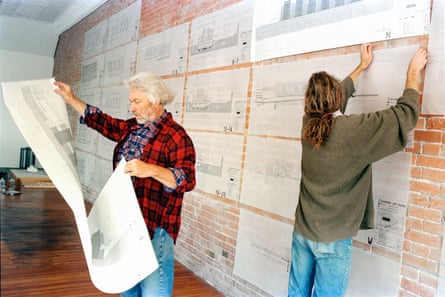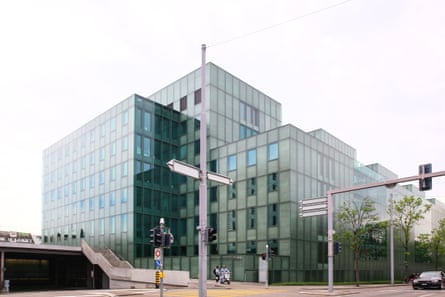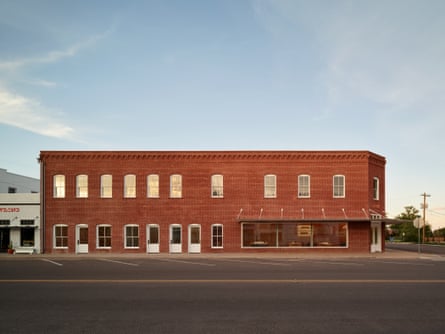The Unseen Architectural World of Donald Judd
A colossal cliff of green-tinted glass stretches along the side of a railway line, shimmering strangely in the light. This isn't a typical office block - it's the Peter Merian Haus in Basel, the largest and perhaps least known work of Donald Judd, one of the 20th century's most important minimalist artists.

He hated most architects … Judd with Jeff Kopie in his Marfa architecture office in 1993.
From Art to Architecture
Few realize that Judd's prolific output extended to building-sized commissions. Before his life was cut short in 1994 at age 65, he was busy setting up an office dedicated to architecture in Marfa, Texas. This office has now been opened to the public following a $3.3 million, seven-year restoration led by Houston architect Troy Schaum.
"Design has to work," Judd famously stated. "Art does not." This philosophy reveals his struggle to move from a pristine universe of pure form into the pragmatic world of planning permissions, clients, and practical functionality.
The Marfa Transformation
Judd moved to Marfa in 1971 to escape the New York art scene, choosing this former ranching town because it was one of the least populated places he could find. Property was cheap and plentiful, so he began buying up vacant hangars, banks, and stores to install his work.

Glass monolith … the Peter Merian Haus in Basel.
By the time of his death, Judd had accumulated 22 properties in Marfa - along with millions of dollars of debt. His son Flavin Judd describes the acquisition process: "Once Don started, he was doomed. It's like being a heroin addict. You have to keep buying the next one and the next one."
The Architecture Office Revealed
The restored architecture office, housed in an innocuous 1900s brick grocery store, provides a fascinating window into Judd's working process as he shifted to architectural scale. The interior has been staged exactly as Judd left it, with his rows of pencils and French curve-rulers arranged like sacred relics.

Ex-grocery store … Judd’s Marfa office is now open for tours.
One wall displays technical drawings of the Basel office block, while Judd-designed tables showcase sketches and models of other projects. Visitors can see prototype porcelain bowls that couldn't go into production because porcelain didn't work in the flat, sharp-edged planes Judd demanded, and his famous plywood chairs that now retail for $9,000.
Unrealized Visions and Professional Conflicts
The office reveals Judd's ambitious but often unrealized architectural visions. A model shows his masterplan for a waterfront site in Cleveland, commissioned in 1986, featuring a series of identical rectangular courtyard blocks marching in a regimented row. The client's favorite architect was Frank Gehry, and Judd's contribution looked more like a bleak business park than a place of waterfront leisure.
Judd also faced professional conflicts, most notably with Swiss architect Peter Zumthor. When Judd was commissioned to design offices for Zumthor's Kunsthaus in Bregenz, Zumthor was incensed, writing: "He should not be working as an architect."
The Legacy of Form Over Function

‘Our approach is to show, not tell’ … inside the Marfa architecture office.
Throughout Marfa, Judd pioneered adaptive reuse long before it was fashionable, stripping structures back to their bones and "correcting" them with additions that often created symmetry or hinted at pure geometric forms. However, his priority of form over function has left a legacy of costly maintenance issues.
At the Chinati Foundation, Judd added huge barrel-vaulted metal roofs to artillery sheds partly to fix leaking flat concrete roofs, but primarily to give the buildings a majestic presence. The architectural historian Julian Rose notes the roof junction was "a three-dimensional nightmare, almost impossible to seal," leading to years of leaks.
Similarly, Judd's decision to use cement mortar with adobe bricks instead of the vernacular mud-based kind has left his perimeter wall with critical structural issues - a whole chunk recently collapsed.
Preserving a Precarious Legacy
Troy Schaum, who leads the restoration efforts, compares maintaining Judd's legacy to "maintaining the Golden Gate Bridge. Once it's completed, you start back at the other end. You think of Judd's legacy as permanent and inevitable. But working out here in the desert, you realize how precarious it actually is."
The Judd and Chinati foundations continue their work preserving these spaces, ensuring that Judd's architectural experiments - with all their practical challenges and aesthetic triumphs - remain accessible for future generations.





Comments
Join Our Community
Sign up to share your thoughts, engage with others, and become part of our growing community.
No comments yet
Be the first to share your thoughts and start the conversation!